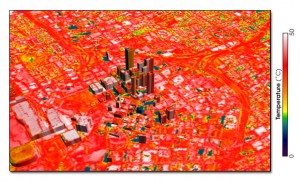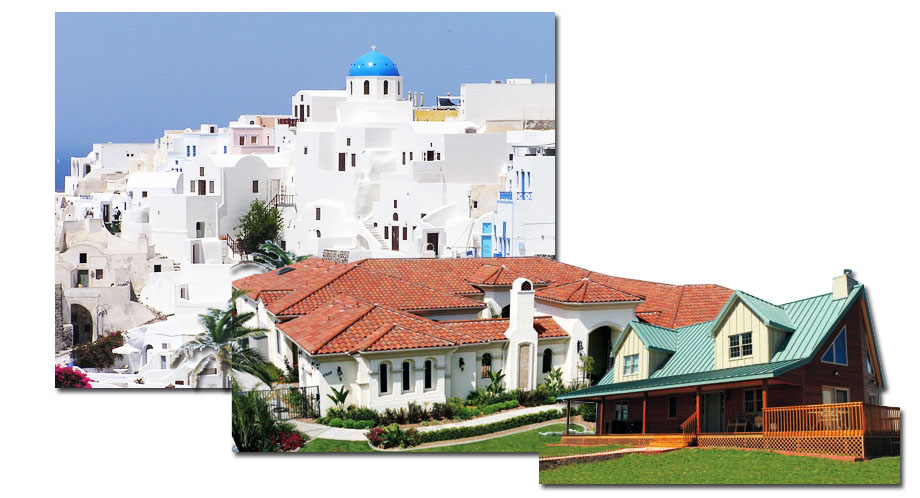Contact: Allan Chen, (510) 486-4210, [email protected]
It’s grade-school science: white reflects sunlight better than dark, so on a hot day people who are wearing light-colored clothing will stay cooler than people wearing black.
This basic principle could help the world fight global warming, as more advanced science has recently helped to demonstrate. Hashem Akbari and Surabi Menon, scientists at the U.S. Department of Energy’s Lawrence Berkeley National Laboratory (Berkeley Lab), and Art Rosenfeld, California Energy Commissioner, Professor Emeritus at the University of California, Berkeley, and former Berkeley Lab scientist, have proposed a “Cool World” plan that would use white roofs, and solar-reflective roofs of other colors, to reduce greenhouse gas emissions and help delay atmospheric heating effects.

Cities like Atlanta, shown here, are heat islands whose temperatures are significantly higher than in surrounding regions. (NASA graphic)
Most existing flat roofs reflect only 10 to 20 percent of sunlight. These roofs absorb much of the remaining solar radiation and heat up the buildings they cover. Buildings with air conditioners expend energy to cool down – energy that’s mostly generated from burning fossil fuels.
On a larger scale, cities heat up more than their rural surroundings because of their dark roofs, dark pavements, and the absence of vegetation – an urban “heat-island” effect that raises the average air temperature of cities and their suburbs.
An effective way to counter the heat-island effect is to reflect more of the sun’s energy back into space. In a paper to be published in the journal Climatic Change, Akbari, Menon, and Rosenfeld estimate that an effort to reroof and repave buildings and streets in the world’s urban areas with “cool” materials, which reflect more sunlight than conventional materials, could offset the global-warming effects of 44 billion metric tons of CO2 emissions.
The average car emits about four metric tons of CO2 per year. Implemented successfully, the Cool World plan would be the equivalent of taking the world’s 600 million cars off the road for 18 years. Rosenfeld, Akbari, and Menon argue that such a global program could achieve the desired result in 20 years, using white and cool-colored roofing and paving materials that are already on the market.
Reducing the urban heat island: from local to global benefits
Researchers at Berkeley Lab’s Environmental Energy Technologies Division (EETD) have been studying the potential effects and benefits of reducing the urban heat island since the 1980s. Akbari, Head of EETD’s Urban Heat Islands Group, Rosenfeld, who was Director of EETD’s Center for Building Science, and others performed research demonstrating that replacing conventional roofs with cool roofs – using solar-reflective materials or just painting them white – could reduce air conditioning energy use on average 20 to 30 percent. With the help of computer simulations the Heat Island Group demonstrated that, on a regional scale, the widespread adoption of cool roofs could actually reduce an urban area’s average summertime temperature.
Berkeley Lab research has shown that the chance of a smoggy day in urban areas such as Los Angeles increases as the average air temperature increases. Reroofing and repaving enough of a city with cool, solar-reflective materials would have the effect of cooling the area and reducing the number of smog episodes.

From traditional Mediterranean houses painted white to modern cool-roof metals, tiles, and shingles that come in colors, cool roofs reduce greenhouse-gas emissions by saving energy. (Santorini photo by Stacy Cashman, licensed under Creative Commons Attribution ShareAlike 3.0. Photos of cool-color roofs courtesy California Energy Commission)
In the 1990s the roofing industry responded to these findings by creating a variety of cool-roof products, including paints, coatings, and elastomeric materials for commercial and industrial buildings. Municipalities, air quality districts, and states began creating incentive programs to hasten the adoption of cool roofs by the marketplace, and the U.S. Green Buildings Council qualified cool roofs as a measure that would count toward receiving a LEED (Leadership in Energy and Environmental Design) rating for an energy-efficient building.
However, while white roofs are common on homes in some parts of the world – notably in the Mediterranean and other hot regions – residential roofs in most of the industrialized world come in a variety of colors and materials. Making asphalt shingle, metal, and tile into cool roofing materials was a challenge.
With funding from the California Energy Commission’s Public Interest Energy Research program, Berkeley Lab established a research plan for developing colored cool-roofing materials. The Urban Heat Islands Group worked with U.S. companies that manufacture more than 90 percent of roofing material products. Akbari, Ronnen Levinson, Paul Berdahl, and Mel Pomerantz conducted this research, in collaboration with colleagues at Oak Ridge National Laboratory and the roofing industry.
The fruits of this cooperation are now widely available in the U.S. marketplace. Cool, solar-reflective roofing materials in a wide variety of colors and all common types, including asphalt shingle, clay and cement tile, and metal, are available from several U.S. roofing material manufacturers. These products have received Energy Star labels, and an industry council, the Cool Roof Rating Council, ensures that cool roofing products are correctly labeled.
Cooling the world
The new research by Akbari, Rosenfeld, and Menon estimates how much cooling might be possible, in equivalent mass of carbon dioxide, by converting roofs and pavements in the world’s urban areas to solar-reflective surfaces. They calculate that retrofitting 1,000 square feet (about 100 square meters) of roof with cool material that reflects 60 percent or more of the sun’s heat would offset the emissions of 10 metric tons of CO2.
In Europe, which has a system of tradable permits for pricing CO2 that uses markets to encourage measures to reduce emissions, CO2 trades at about $25 per metric ton. That makes a 10-metric ton offset worth $250. At this price, the 44 billion metric tons of greenhouse-gas (GHG) emissions that cool materials could offset is equal to about $1.1 trillion.
The researchers also estimate that 50 percent of the world’s population now lives in urban areas; by 2040, that fraction is expected to rise to 70 percent. Growth in the urban population of the planet helps explain why measures focused on reducing urban GHG emissions could have such a large impact on climate change.
“Cool surfaces are a simple, tried-and-true technology for cooling the earth,” says Akbari. “Using them is a simple but effective solution to help reduce earth’s climate change. And by doing this globally, we can gain experience in how to work together to implement large scale solutions to reducing global warming.”

Within 30 years, more than two-thirds of all the people on Earth will live in cities. Cooling cities helps cool the planet. (After NASA)
Additional information
“Global Cooling: Increasing World-wide Urban Albedos to Offset CO2,” by Hashem Akbari, Surabi Menon, and Arthur Rosenfeld, will appear in Climate Change 2008 and is available online at http://www.energy.ca.gov/2008publications/CEC-999-2008-020/CEC-999-2008-020.PDF
More about the Heat Island Group in Berkeley Lab’s Environmental Energy Technologies Division is at http://heatisland.lbl.gov/
More about cool colors for roofing materials is at http://www.lbl.gov/Science-Articles/Archive/sb/Aug-2004/3_coolroofs.html and at http://coolcolors.lbl.gov/
More about standards for cool roofing products is at http://www.energystar.gov/index.cfm?c=roof_prods.pr_roof_products and at http://www.coolroofs.org/